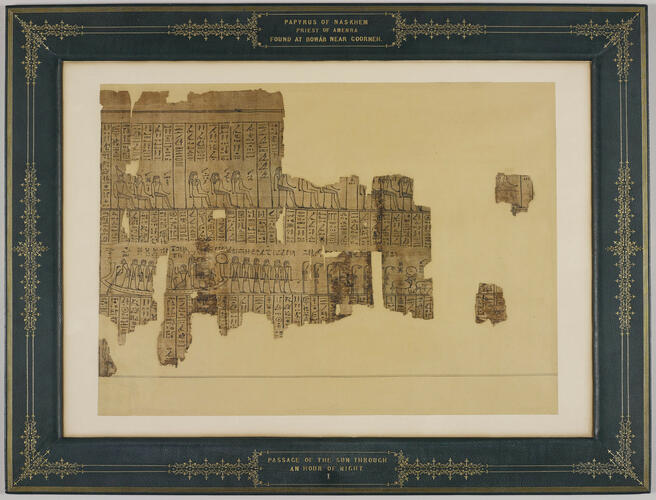-
1 of 253523 objects
Section of the papyrus belonging to Nesmin, with the eighth hour of the Amduat c. 300-275 BC
61.5 x 80.5 cm (mount) (whole object) | RCIN 1145259
-
Section of the papyrus belonging to ‘God’s Father and Prophet of Amun-Ra, King of the Gods, Nesmin, born of the Lady of the House, Sistrum-player of Amun-Ra, Tasherit(en-ta)ihet’ with the eighth hour of the Amduat (see also RCINs 1145260-66).
The Amduat (literally ‘that which is in the netherworld’), also known as the Book of the Hidden Chamber, is a funerary text that describes the journey of regeneration of Ra, the Egyptian sun god, through the 12 hours of the night from sunset (symbolising death) to sunrise (symbolising rebirth). The text starts appearing in royal tombs from around 1500 BC, and the two most notable examples are perhaps those painted on the walls of the burial chambers of Thutmose III (1479–1425 BC) and Amenhotep II (1427–1400 BC) in the Valley of the Kings, Thebes. It represents an important stepping stone in the literary tradition of ancient Egypt, being the model for later Books of the Afterlife, and it maintains its relevance well into the Graeco-Roman era.
The main aim of the text is to offer a description of the netherworld so that the deceased, as well as the living, are able to gain familiarity with what to expect when their journey into the afterlife begins. Knowledge of the secret paths of the netherworld offers protection to the deceased from the dangers and threats he/she may encounter; the text shows the obstacles and demons that could obstruct a safe passage through the hereafter as well as the deities and beings able to assist and help the deceased towards the completion of the journey of regeneration.
The eighth hour of the Amduat, unfortunately preserved in a quite lacunose state in this papyrus, presents the upper and the lower registers arranged in a symmetrical structure, like in the first hour. This symbolises that, with the defeat of Apophis in the previous hour, chaos has been left behind and the order of creation has been reinstated. Both the upper and lower registers depict five 'caverns' or 'vaults' in which various deities, in groups of three or sometimes four, are seated on (or sometimes standing next to) the hieroglyph for clothing, meaning that they have been provided with clothes. The first nine gods included in the first three upper caverns are the ones forming the Great Ennead of Heliopolis, reinforcing once again the idea of the order of creation or, more specifically in this instance, re-creation. In addition, providing new clothing is in itself a concrete and tangible way to express the concept of renewal.
This is the last hour included in the papyrus acquired by Albert Edward, Prince of Wales, later King Edward VII, during his 1862 visit to Egypt. The papyrus was found rolled and attached to a mummy with bitumen, which damaged most of the lower part of the text. It is possible that the last four hours of the Amduat were never included in the papyrus or, perhaps, that part of the item was found badly damaged by the bitumen and in a too fragile state of preservation to be recovered.
Egyptologist Samuel Birch published his study of the papyrus in 1863 (RCIN 1079232). A facsimile was published in 1913 with the hieroglyphic transcripts, translations and an introduction by E.A. Wallis Budge.
A more recent English translation of the complete text of the Amduat can be found in Hornung, E and Abt, T eds, 2007. The Egyptian Amduat. The Book of the Hidden Chamber. Zurich: Living Human Heritage, while a psychological interpretation of the text is presented in Schweizer, A, 2010. The Sungod’s Journey through the Netherworld. Reading the Ancient Egyptian Amduat. Ithaca, NY and London: Cornell University Press.Provenance
Excavated in Egypt at the Dra' Abu el-Naga' necroplis, near Deyr el-Bahri, part of the larger Theban necropolis, 1862 by Mustafa Aga Ayad, consular agent to the United Kingdom. Acquired by King Edward VII, when Prince of Wales, during his 1862 tour of the Middle East.
-
Measurements
61.5 x 80.5 cm (mount) (whole object)
35.5 x 53.8 cm (sheet of paper)
86.5 x 67.0 cm (book in box)
Category
Alternative title(s)
Passage of the sun through an hour of the night ; 1. (Papyrus of Nas-Khem Priest of Amen-Ra).


